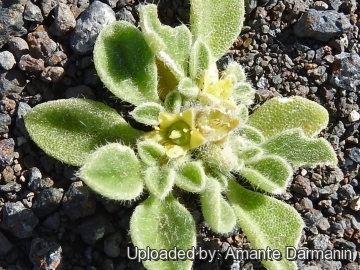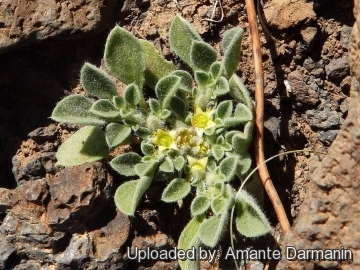
Aizoon canariense Photo by: Amante Darmanin
This species is very common on the islands of Fuerteventura, Lanzarote and La Graciosa (Canary). This is an annual from the Aizoaceae family and is covered in fine, velvety hairs. This species is also found in Mauritania, Mali and other parts of Africa, even in Qatar and eastward to Packistan.
The fruits are star-shaped, much depressed centrally, usually red or pink. The petal-less flowers are small and greenish.
Origin and Habitat: Tropical and North Africa from the Atlantic Islands (Canaries) and Cape Verde eastward through northern Africa to Egypt and Sudan, Arabia, Baluchistan, southern Iran, Afganistan and Pakistan, in the drier regions; also in Mozambique, Angola, Zimbabwe, South Africa, and Namibia.
Altitude range: from sea level to 2000 metres.
Habiatat and ecology: Aizoon canarienseSN|33705]]SN|33705]] is found in salty and non-salty habitats in hot desert areas, mainly in sandy places and gravel plains. This species is also found on disturbed land, such as on roadsides, cultivated ground and on rocky soils. It is mainly found in areas where rainfall occurs in the summer, although it is able to withstand a certain amount of winter rain. This species has also been recorded on offshore islands. There are currently no known threats to this species.
Synonyms:
See all synonyms of Aizoon canariense
back
Accepted name in llifle Database:Aizoon canariense L.Sp. Pl. 488 1753.Synonymy: 6
back
Common Names include:
ENGLISH: purslane-leaved aizoon
SPANISH (Español): patilla, pata perro
Description: Aizoon canariense is a prostrate rather thick-stemmed and tough annual or short-lived perennial succulent herb, the branches are often widely spreading, woody towards the crown, more or less uniformly hairy or papillose. It is often only a few cm tall and wither quickly and totally after seeding. The apetalous, stemless flowers are greenish outside and yellowish within, with a perianth of 3-5 mm long lobes. This species is very variable in the size of its parts and in its degree of hairiness. The tissue of these succulents can store water that may be used later in the growing season. They are characterized by shallow roots and survive throughout a season longer than other ephemerals.
Derivation of specific name: “canarianse” geographical epithet that refers to the Canarian archipelago.
Stems: Herbaceous, procumbent, thick and tough, branching radially from the base and often zigzag, villous, often also finely papillose. Primary branches 1–5 mm in diameter, 5-30 cm long or more.
Leaves: Regularly alternate, flat on the ground, entire, 6-70 mm long, 2–45 mm broad, suborbicular, elliptical, obovate-cuneiform, to spathulate, obtuse, or bluntly subacuminate at apex, with curled edges, attenuated in a petiole nearly as long than the lamina (3-18 mm long), more or less pubescent on both sides.
Flowers: The flowers are hermaphrodite (have both male and female organs). They are apetalous, solitary, sessile, often numerous in the axils or in the forks of branches almost fused at the origin of the branches. Calyx 5 (rarely 4) -angled. Perianth segments (sepals) triangular to ovate, persistent, acute, 1-2 mm long or longer, yellowish inside, greenish or reddish and pilose outside imbricate in aestivation. Stigmas 5, thick. Stamens about 12–15(-20), inserted on the calyx-tube in fascicles at the bases of the sinuses between the calyx-lobes. Filaments c. 1 mm long. Ovary (4-)5-locular. Styles (4-)5, free, short, c. 1 mm long, papillose, linear, persistent or deciduous, stigmas (4-)5.
Blooming season: A. canariense is reported to bloom at different times in different parts of its range. In the United Arab Emirates, the purslane-leaved aizoon flowers between January and June, while in Pakistan this species flowers between September and November.
Fruit (capsule): Pentagonal and star-shaped at apex, much depressed centrally, (rarely tetragonal), woody, usually red or pink, 5-9 mm in diameter, opening by 5 (rarely 4) inflexed valves, which remain attached to the centre of the ovary. ). The fruit is capable of remaining on a dead plant for a long period of time.
Seeds: Many, c. 0.9 mm long, reniform, black, shiny, concentrically ridged and rain-dispersed.
Bibliography: Major references and further lectures
1) W. Sonder “Flora Capensis”, Vol 2, 1894
2) J. G. Baker “Flora of Tropical Africa”, Vol 2, 1871
3) C. Jeffrey “Flora of Tropical East Africa”, 1961
4) M. L. Gonçalves “Flora Zambesiaca” FZ, Vol 4, 1978
5) M. G. Gilbert “Flora Somalia”, Vol 1, 1993 [updated by M. Thulin 2008]
6) Heidrun E.K. Hartmann “Illustrated Handbook of Succulent Plants: Aizoaceae A-E” Springer Science & Business Media, 06 December 2012
7) Padilla, D.P., González-Castro, A. and Nogales, M. “Significance and extent of secondary seed dispersal by predatory birds on oceanic islands: the case of the Canary archipelago.” Journal of Ecology, 100: 416-427. 2012.
8) Wildscreen Arkive “Purslane-leaved aizoon (Aizoon canariense)” http://www.arkive.org/purslane-leaved-aizoon/aizoon-canariense/#ref3
9) B.S. Middleditch “Kuwaiti Plants: Distribution, Traditional Medicine, Pytochemistry, Pharmacology and Economic Value” Elsevier, 02 December 2012
10) M.A. Zahran, A.J. Willis “The Vegetation of Egypt” Springer Science & Business Media, 23 November 2008
11) James P. Mandaville “Bedouin Ethnobotany: Plant Concepts and Uses in a Desert Pastoral World” University of Arizona Press, 15 June 2011
12) Mandaville “Flora Of Eastern Saudi Arabia” Routledge, 06 August 2013
13) Aizoon canariense in: "Flora de Canarias" URL http://www.floradecanarias.com/aizoon_canariense.html
14) Nasir, E. & S. I. Ali (eds). “Flora of Pakistan” Univ. of Karachi, Karachi.1980-2005.
15) Jongbloed, M.V.D “The Comprehensive Guide to the Wild Flowers of the United Arab Emirates.” Environmental Research and Wildlife Development Agency, Abu Dhabi.. 2003
16) Wickens, G.E. “Ecophysiology of Economic Plants in Arid and Semi-Arid Lands.” Springer, Berlin. 1998.
17) Aizoon canariense in: “Flora of Pakistan” http://www.efloras.org/florataxon.aspx?flora_id=5&taxon_id=220000384
18) Miller, A.G., Cope, T.A., Nyberg, J.A., Royal Botanic Garden, Edinburgh, and Royal Botanic Gardens, Kew “Flora of the Arabian Peninsula and Socotra”, Volume 1. Edinburgh University Press, Edinburgh. 1996.
19) Mahmoud, T. “Desert Plants of Egypt’s Wadi El Gemal National Park.” American University in Cairo Press, Cairo. 2010
20) Gutterman, Y. “Regeneration of Plants in Arid Ecosystems Resulting from Patch Disturbance.” Springer, Berlin. 2001.
 The flowers are apetalous with triangular segments, 2-3 mm long , yellowish inside, greenish or reddish and hairy outside. Photo by: Amante Darmanin
The flowers are apetalous with triangular segments, 2-3 mm long , yellowish inside, greenish or reddish and hairy outside. Photo by: Amante Darmanin Aizoon canariense Photo by: Amante Darmanin
Aizoon canariense Photo by: Amante DarmaninCultivation and Propagation: Aizoon canarienseSN|33705]]SN|33705]] is a succulent annual, suitable for: light (sandy), medium (loamy) and heavy (clay) soils. It adapts to acid, neutral and basic (alkaline) soils and can grow in saline soils. It is only rarely seen in cultivation as it has to be raised from seed. It grows as a small-scale ground-cover which spreads outward by means of seeds over time. It can can tolerate sun, shade, and dry soils, but looks its best only when given adequate light levels and water, and ideally should be grown outdoors in full sun. With its extreme drought resistance, A. canariense needs only minimal care to reward you with its attractive texture.
Exposure: It prefers light shade with ample airflow rather than full sun, except in cool coast-side locations.
Waterings: They are able to tolerate extended dry periods and survive drought without the need for watering, but they will grow stronger if they receive adequate moisture during their growing season, but never allowing the plant to remain waterlogged (root rot sensitive). Avoid overhead watering under humid conditions, especially during winter.
Ventilation: Good air movement is important for minimising pest and disease risks, and avoiding excessive humidity in cool winter conditions is important to successfully growing in the nursery environment.
Hardiness: Though not terrifically cold-hardy, it can take overnight temperatures to -3(-10) C however, the ideal temperature range during the summer growing season is 5-25°C.
Traditional uses: The herb is consumed as a food by the Tuareg, and also by camels in Kuwait. The seeds are edible.
Propagation: Seeds.












